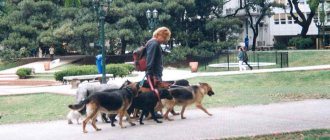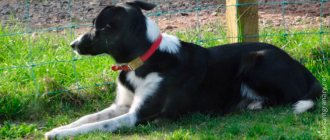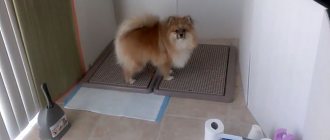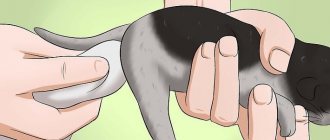The “Near” command is one of the most difficult tasks for a dog, so you shouldn’t blame your pet if he can’t complete it. It often seems to owners that the animals are being stubborn on purpose, which is why the dog is subjected to a barrage of unpleasant words. Your pet may simply not understand what is required of him. He tries to please you, so if he doesn't succeed, you may not be explaining the command clearly.
“Nearby” is a word, upon hearing which the dog should run up to you from the left side, its shoulder should not go beyond the border of your leg. She should remain in this position until you allow her to go for a walk or do something else.
Many people don't know how to teach an adult dog the "Near" command. This is a really difficult task, since conditioned reflexes need to be developed in a pet from childhood. In this case, training should begin immediately after the animal has learned to walk on a leash and has stopped pulling on it. This usually occurs at 7 months of age. But if you wish, you can carry out the following manipulations with a dog of any age.
Teaching your pet to walk next to you on a leash
Some trainers know all the intricacies of animal training, but do not know how to teach a dog the “Near” command on a leash. You can see photos of such training below. In fact, this is the first stage of training. The dog will not understand what you want from it if you immediately let it off the leash and insist on walking next to you. It is better to proceed according to the following scheme:
- Say “Near” and pull the leash lightly towards your left leg, which is where you want the dog to stand.
- In this position, walk with your pet a few meters.
- Loosen the tension slightly to give your dog more freedom.
- If your pet continues to walk near you without any effort on your part, praise him verbally.
- Even if your dog actively and willingly follows your commands, do not give him a treat while walking. This can confuse your pet, causing his attention to turn to food.
- If the pet does not listen to you and leaves as soon as you release the tension, patiently repeat all the above manipulations. Sooner or later the dog will understand what you want from it.
- Your movement should be uniform. Do not change speed or swerve while your dog is going through the initial stages of training.
- Don't be nervous or angry with your pet. He will worry that he has not pleased you and will be nervous, as a result of which his performance and desire to learn will completely disappear.
- If the dog already understands well what is required of it and follows your instructions, loosen the leash and say “Walk.” After this, you can give your pet a treat and praise him.
- If the pet has not completed its task, then it should not be rewarded with food.
These manipulations are just the first stage of training. When your pet successfully passes it, immediately begin training him using a more complicated method.
Teaching your dog the command “Near”
The development of this skill occurs after the puppy has adapted to the collar and leash. Classes should be held in familiar areas. The conditioned stimulus represents the order “Near”, the unconditioned stimulus represents a jerk of the leash. The dog should be on a short leash at the left leg of the owner, who begins the movement, while allowing it to move in a free direction. If the pet runs forward, then first on command and then with a jerk it is necessary to return it to the owner’s left leg. When the dog has chosen the required position, you need to stroke it with your left hand, treat it and say the command again.
As soon as the pet moves to the side or lags behind, the order “Nearby” comes and a jerk towards itself. After some time, the dog will learn to approach the owner on command without waiting for a jerk. You can check whether the puppy’s skill has been fixed in the following way: when the pet runs away or lags behind, try to return it to the required place only with the help of your voice, without jerking. If the puppy returns to the owner’s left leg, then we can say that the skill has been formed, and if not, then you need to continue the exercises. Gradually, he learns to walk side by side even with various distractions.
When the command is given
The order must be given before the start of the movement and before the place of the intended stop. First, “Nearby” is pronounced, and then the move begins, that is, on command, a stop is made and a step begins. During a stop, the pet should sit not at a distance, but near the owner’s leg. Also, on command, a turn is made, that is, “Nearby” goes first, and then you can change the location. Before changing the pace of movement, the puppy needs to give a command, and then only slow down or speed up.
After about a week, the dog will master the command and then it will be possible to make the task a little more complicated: making movements in a crowd of people, while running or walking slowly, and also without a leash.
Second stage of leash command training
When the dog has already clearly understood its task, proceed to the second stage of training:
- Lead your pet on a loose leash.
- If the dog deviates from the instructions, give a slight tug with the leash. This should be a punishment for disobedience.
- Change the speed and direction of movement.
- Don't forget to praise your pet for correctly executed commands.
Remember that if during movement you give a command a second time and the pet obeys, this is not a correctly completed task. The dog should walk next to you at the first word, and stop doing so only with your permission. If you change the speed or direction of movement too sharply, the pet simply will not have time to adjust. In this case, you cannot scold him.
How things are in reality
Currently, the position of the dog to the left of the owner can be both an advantage and cause the person handling it to experience some inconvenience.
Advantages:
- When a person walks with a pet down the street, holding it on the left side, he can shake hands with friends, salute (if he is a military man), carry a bag of groceries in his right hand (whichever is more convenient), without touching the dog with it.
- Having passed the standards for the OKD (general training course), the dog begins to move with the person (he performs with the left leg), without stopping at the start.
When passing the OKD standards and at competitions in the left position, the dog loses less time at the start
The inconvenience may be due to the fact that the pet is walking in the middle of the road (sidewalk). Therefore the following are not excluded:
- communication (or conflicts) with oncoming dogs, who also walk to the left of their owners;
By occupying a position on the left, dogs can come into close contact with oncoming pets
- unpleasant situations when a passerby coming towards you does not like or is afraid of dogs.
Taking into account different possible situations, trainers can train the dog to follow the command “Near!” both left and right depending on need.
I picked up my dog as an approximately 3-4 month old puppy on the street. This is my first dog pet, before that I only dealt with cats. She lives in my yard in a booth, but I try to take her for a walk (to stretch her legs and see the world). It didn’t occur to me to find out on the Internet how to properly lead a dog on a leash; we are not going to exhibitions. Therefore, solely out of my own convenience, I lead it from the right. Firstly, the dog has grown quite big, and if something happens, I won’t be able to hold it with my left hand. And secondly, she loves everyone very much, especially women (apparently, they were the only ones who fed her during her wanderings). Therefore, at the sight of any woman coming towards her, she is still ready to rush to her with open arms. That’s why he walks to the right, along the fences, away from passers-by.
How to teach your dog the “Near” command without a leash
You need to start this stage only when your pet is already performing tasks on a leash perfectly, clearly, quickly and correctly. So, how to teach a dog the “Near” command at home:
- Use a long leash first. Proceed in the same way as in the second stage.
- If your pet is far from you, first you need to give him the command “Come to me”, and then “Nearby”.
- When the dog easily follows your instructions, release him from the leash completely and repeat the above manipulations.
- Your dog will not regularly follow this command off-leash unless you periodically train him on-leash. In this case, within a week all skills will be lost.
Remember that this command is not always appropriate.
What mistakes are best to avoid during training?
Basic recommendations to prevent errors that hinder learning:
- It is necessary to monitor your manipulations and not pull the leash until the command is announced.
- Often, newcomers to dog breeding lead their pet on a leash that is too tight - this is a common mistake. The animal must understand the difference between walking on a leash and jerking.
- It is important to observe the tone when pronouncing the command. Because of the angry and threatening intonation, the dog will begin to think that he is being punished this way.
- Very frequent and sudden changes in direction and speed confuse the pet.
- There is no need to quickly start practicing the command without a leash. A sequence of actions is required, consolidation of all stages of training.
- It is necessary to teach a command after consolidating the previous one. This is important for animals learning tricks. Too much information makes it difficult to identify one new skill from many, which will lead to confusion.
- Don't use the command too often. The pet does not need to walk near the owner always, so there is no need to say “Near” if the dog moves away a little. When he deviates slightly from the course, you should carefully pull the leash.
Training can be difficult if your pet is distracted and distracted. In this case, you should seek the help of a dog handler.
When to give the “Nearby” command
We figured out how to teach a dog the “Near” command. The instructions are given above, but this information is not enough for successful training. This task should be set before the animal only in the following cases:
- At the same time you start moving.
- Immediately before stopping you need to say “Nearby, sit.”
- Before you are about to turn the other way.
- Immediately after you change the pace of movement.
This command is aimed primarily at ease of movement on the street. The pet must accompany you at all times. Without training, he will not immediately understand that you have turned, that he cannot move in the old way. Therefore, such training will benefit you.
Under what conditions should training be performed?
In order for the training process to be effective, certain conditions must be met. This:
- The dog must be healthy. If the pet is lethargic and refuses active games and walks, it is better not to train it yet.
- You should not practice the exercise as soon as you go outside. The pet needs to relieve itself, play and waste some energy.
- You should choose a place for training away from people, other animals, and any distractions. When the dog can calmly perform “Next” on a leash, you can move to a busier place.
A day of 10-15 minutes of practice for each exercise is enough. You don’t need to teach your animal to walk next to you for an hour - the dog will get tired and will not respond to your words properly.
How much time to devote to training
In the first stages of training, this command should be practiced for no more than 10 minutes per training session. Gradually increase this time to 20 minutes.
Try to combine several commands at each lesson so that the dog does not get bored and lose interest in learning.
When your pet has completely mastered this task, you can arrange small training sessions on each walk. But this option is acceptable only if the dog does not experience discomfort when executing the command.
Standards
To position the dog's head correctly, special harnesses are used.
The given standards apply to those individuals that are intended for performances. Getting your companion dog to follow you exactly in any situation is unnecessary. For a pet, the command should mean:
- movement is strictly at the owner’s left foot. The shoulder should be parallel to the person's knee. She should move at the same pace as the conductor, being at a minimum distance from him. At the very beginning of training, a half-meter gap between the animal and the owner can be allowed, but over time this gap must be reduced. The dog should almost stick to the person's leg;
- the head is positioned straight. Sometimes the dog raises its muzzle, looking at the owner’s face - this is acceptable. To practice correct head positioning, you need special harnesses ;
- if the trainer stops, the dog must sit up on its own without waiting for a sign or command. The croup is close to the leg. In the absence of a command, an ideally trained dog does not change its position. If the trainer turns around, the animal follows him and sits down again;
- when executing the “near” command from a distance, the dog must go around the owner and sit next to the left leg;
- When the trainer turns, the dog goes around him from behind.
It should be borne in mind that for animals that are not preparing for performances, the movement may be such that it does not cause discomfort to the owner . For example, for left-handers, you can teach your dog to walk on the right. The main thing is confidence in the complete control of the animal, which moves at your feet without a leash.
If you got yourself a German Shepherd puppy, check out what age and how to raise a German Shepherd, as well as how to train it. If you have taught your dog the basic commands, it will not be superfluous to teach the dog the give paw command.
Training place
The place where the training will take place should be familiar to your pet. It is also important that no extraneous factors distract the dog.
Try to find a place where there will be no strangers, and the area will be large enough for the pet to feel free.
Before starting training, the dog should get some exercise. At later stages, you need to move to a site where extraneous factors will be present.
Practicing the command “Near!” in a young dog
The dog grows, and in the transition period of eight months he is less and less inclined to obey his owner, and is more and more susceptible to a hormonal explosion. Males become especially disobedient and cocky: they strive to mark every bush in their territory and engage in battle with any opponent.
It’s not easy to get a young dog to walk next to you.
Since a one-year-old animal already knows and understands a lot, you should begin more thoroughly practicing the command “Near!” To do this, the owner makes it a rule any movement of the dog on a leash with the requirement to walk alongside, without lagging behind or running ahead.
- If your pet is a large breed, then to facilitate the training process it is wise to use a strict collar. The jerk of the leash becomes more noticeable, and the owner does not have to make much effort to control the dog.
- The command is given only when the dog violates the imaginary line, and a sharp jerk with the leash is required.
- If the dog rebels when it sees a rival or a cat in the distance, then you should stop, sit the animal down, and carry out several exercises to carry out general obedience commands. It is necessary to force the dog to follow the commands “Sit!”, “Stand!” and “Lie down!” several times, after which you can turn around and walk in the opposite direction from the stimulus for a while. After walking a few meters, make a U-turn and be sure to pass by the irritant. Let the dog puff and “prance,” but you need to force him to walk next to you, making strong, sharp jerks with the leash.
The main mistakes of trainers
Often the dog does not follow the command due to the trainers' mistake. The most common of them:
- Giving a command to your pet immediately after a strong jerk with the leash.
- Sudden change in speed.
- Constantly repeating a command unnecessarily.
- Giving commands in an overly stern or threatening voice.
- Moving too quickly to a more difficult stage.
Gain strength, patience, get rid of anger before starting training, and the “Nearby” command will no longer be a problem for you.
Common mistakes
There are the most common mistakes that make the training process difficult. It is necessary to pay attention to the following points:
- You cannot first tug on the leash and then say an order, because otherwise the puppy will react not to the command, but to the tug.
- You should not keep a constantly taut leash and drag a reluctant animal behind you. After saying “Nearby,” you need to briefly pull the leash.
- You should not allow your pet to ignore the command; until it is fully mastered, you need to reinforce it with a jerk.
- You cannot shout at the dog or tug the leash too hard, otherwise you can injure him.











